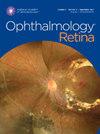基于国际分类系统的高风险视网膜母细胞瘤:1362只眼的分析。
IF 5.7
Q1 OPHTHALMOLOGY
引用次数: 0
摘要
目的:探讨国际眼内视网膜母细胞瘤分级方案和美国癌症联合委员会(AJCC)分级对组织病理学高危特征(HRF)的预测价值。设计:多中心国际合作回顾性病例系列。研究对象:来自11个国家16个中心的1362例视网膜母细胞瘤患者。干预措施:原发性去核;HRF患者的辅助治疗。主要结局指标:高风险视网膜母细胞瘤,定义为一个或多个HRF(前段受累,大量脉络膜浸润,轻微脉络膜浸润伴层前视神经浸润,层后或切除视神经切端受累,巩膜或显微巩膜外浸润);无转移生存期(MFS)结果:1362例患者中,751例(55.1%)有HRF。根据国际视网膜母细胞瘤分类(ICRB)[费城vs洛杉矶(LA)]与儿童肿瘤组(COG)分类方案,D组眼HRF阳性预测值(PPV)分别为42.0% vs 35.1% vs 43.2%, E组眼HRF阳性预测值分别为58.5% vs 59.0% vs 59.5%。比较D组与E组,采用ICRB费城分级法(0.7 (0.9,0.0 - 6.0)vs. 1.3 (1.7, 0.0 - 9.0), p < 0.001)、ICRB LA分级法(0.6 (0.8,0.0 - 6.0)vs. 1.3 (1.7, 0.0 - 9.0), p < 0.001)和COG分级法(0.8 (1.2,0.0 - 7.0)vs. 1.3 (1.6, 0.0 - 8.0), p < 0.001), E组HRF平均数目(SD, range)更高。AJCC临床肿瘤(cT)组cT3a HRF的PPV高于55%,通过cT3e增加至72.3%。ICRB费城与ICRB LA、ICRB LA与COG和ICRB费城与COG之间的协议分别为0.9、0.8和0.8 (p < 0.001)。无转移生存率和总生存率在所有眼内视网膜母细胞瘤分类方案之间也具有可比性,但在AJCC方案中分层更好。结论:所有眼内视网膜母细胞瘤分类方案均可预测HRF和MFS。E组包括相当于AJCC组cT3的宽频谱。统一分组并进行E组亚分类,可改善风险分层。我们建议视网膜母细胞瘤世界的所有人今后在所有报告和出版中采用AJCC分类。本文章由计算机程序翻译,如有差异,请以英文原文为准。
High-Risk Retinoblastoma Based on International Classification Systems
Purpose
To determine the predictive value of International Intraocular Retinoblastoma Classification schemes and the American Joint Committee on Cancer (AJCC) classification for histopathological high-risk features (HRFs).
Design
Multicentric international collaborative retrospective case series.
Subjects
One thousand three hundred and sixty-two patients with retinoblastoma from 16 centers and 11 countries.
Intervention
Primary enucleation; adjuvant therapy in patients with HRF.
Main Outcome Measures
High-risk retinoblastoma defined as 1 or more HRF (anterior segment involvement, massive choroidal invasion, minor choroidal infiltration with prelaminar optic nerve invasion, retrolaminar or resected optic nerve cut end involvement, scleral or microscopic extrascleral infiltration); metastasis-free survival (MFS).
Results
Of the 1362 patients, 751 (55.1%) had HRF. According to the International Classification of Retinoblastoma (ICRB) (Philadelphia vs. Los Angeles [LA]) versus Children’s Oncology Group (COG) classification schemes, the positive predictive value (PPV) of group D eyes for HRF was 42.0% versus 35.1% versus 43.2%, respectively, and that for group E eyes was 58.5% versus 59.0% versus 59.5%, respectively. Comparing group D versus group E eyes, there was higher mean number of HRF (standard deviation, range) among group E eyes using the ICRB Philadelphia (0.7 [0.9, 0.0–6.0] vs. 1.3 [1.7, 0.0–9.0], P < 0.001), ICRB LA (0.6 [0.8, 0.0–6.0] vs. 1.3 [1.7, 0.0–9.0], P < 0.001) and COG (0.8 [1.2, 0.0–7.0] vs. 1.3 [1.6, 0.0–8.0], P < 0.001) classifications. The PPV for HRF was above 55% for AJCC clinical tumor (cT) group cT3a with increments through cT3e to 72.3%. An agreement between ICRB Philadelphia versus ICRB LA, ICRB LA versus COG, and ICRB Philadelphia versus COG was 0.9, 0.8, and 0.8, respectively (P < 0.001). Metastasis-free survival rates and overall survival rates were also comparable between all intraocular retinoblastoma classification schemes but better stratified within the AJCC scheme.
Conclusions
All intraocular retinoblastoma classification schemes predict HRF and MFS equally. Group E includes a wide spectrum equivalent to the AJCC group cT3. Uniform grouping with subcategorization of group E might improve risk stratification. We propose that everyone across the retinoblastoma world henceforth adopts the AJCC classification for all reporting and publishing.
Financial Disclosure(s)
The authors have no proprietary or commercial interest in any materials discussed in this article.
求助全文
通过发布文献求助,成功后即可免费获取论文全文。
去求助

 求助内容:
求助内容: 应助结果提醒方式:
应助结果提醒方式:


